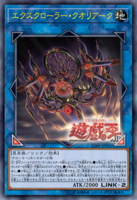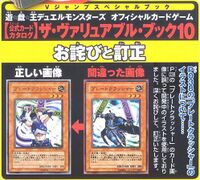Difference between revisions of "Official Proxy"
Vortexdome (talk | contribs) (→Examples) |
|||
| (5 intermediate revisions by 3 users not shown) | |||
| Line 1: | Line 1: | ||
| − | An '''Official Proxy''' is a | + | An '''Official Proxy''' is a sample image of a card that is usually used in place of an unreleased card. These are commonly used in articles to advertise upcoming sets. Official Proxy images can be identified by the lack of [[password]] and a simplified or absent [[security foil]]. |
| − | Websites using Official Proxies include Konami's Yu-Gi-Oh! official | + | Websites using Official Proxies include Konami's official Yu-Gi-Oh! sites and social media, as well as VIZ Media's official site. Official Proxies can also be found in issues of ''[[Weekly Shōnen Jump]]'' and ''[[Shonen Jump]]'', as well as on Sneak Peek posters. |
| + | |||
| + | Modern ''[[OCG]]'' Official Proxies normally feature a capitalized "SAMPLE" watermark superimposed on the [[card text]] box or in the lower-right corner of its [[artwork]]. A notable exception to this is [https://yu-gi-oh.jp/ YU-GI-OH.jp], whose proxies instead use the website's logo along with the text 「無断転載禁止」 ("Unauthorized reproduction prohibited"). | ||
| + | |||
| + | Official Proxies are not guaranteed to match the released card, although they typically do. For example, "[[Seismic Crasher]]" had a different artwork on its Official Proxy to its eventual print, and several cards have had their card text changed before their release. | ||
| − | |||
| − | |||
| − | |||
| − | |||
==Examples== | ==Examples== | ||
| − | <gallery widths="200" position="center" captionalign="center"> | + | <gallery heights="200" widths="200" position="center" captionalign="center"> |
| − | + | ShelrokketDragon-EXFO-JP-OP.png | Official Proxy of "[[Shelrokket Dragon]]", from the official ''OCG'' Twitter account | |
| − | SeismicCrasherV-Jump.jpg | The Official Proxy of "[[Seismic Crasher]]" had its artwork replaced. | + | XKrawlerQualiark-CIBR-JP-OP.png | Official Proxy of "[[X-Krawler Qualiark]]", the first one ever published on YU-GI-OH.jp |
| + | SeismicCrasherV-Jump.jpg | The Official Proxy of "[[Seismic Crasher]]" had its artwork replaced. | ||
</gallery> | </gallery> | ||
| − | |||
| − | + | {{Card layout}} | |
| − | [[Category: | + | |
| + | [[Category:Card layout]] | ||
Latest revision as of 16:16, 14 October 2023
An Official Proxy is a sample image of a card that is usually used in place of an unreleased card. These are commonly used in articles to advertise upcoming sets. Official Proxy images can be identified by the lack of password and a simplified or absent security foil.
Websites using Official Proxies include Konami's official Yu-Gi-Oh! sites and social media, as well as VIZ Media's official site. Official Proxies can also be found in issues of Weekly Shōnen Jump and Shonen Jump, as well as on Sneak Peek posters.
Modern OCG Official Proxies normally feature a capitalized "SAMPLE" watermark superimposed on the card text box or in the lower-right corner of its artwork. A notable exception to this is YU-GI-OH.jp, whose proxies instead use the website's logo along with the text 「無断転載禁止」 ("Unauthorized reproduction prohibited").
Official Proxies are not guaranteed to match the released card, although they typically do. For example, "Seismic Crasher" had a different artwork on its Official Proxy to its eventual print, and several cards have had their card text changed before their release.
Examples[edit]
Official Proxy of "Shelrokket Dragon", from the official OCG Twitter account
Official Proxy of "X-Krawler Qualiark", the first one ever published on YU-GI-OH.jp
The Official Proxy of "Seismic Crasher" had its artwork replaced.


